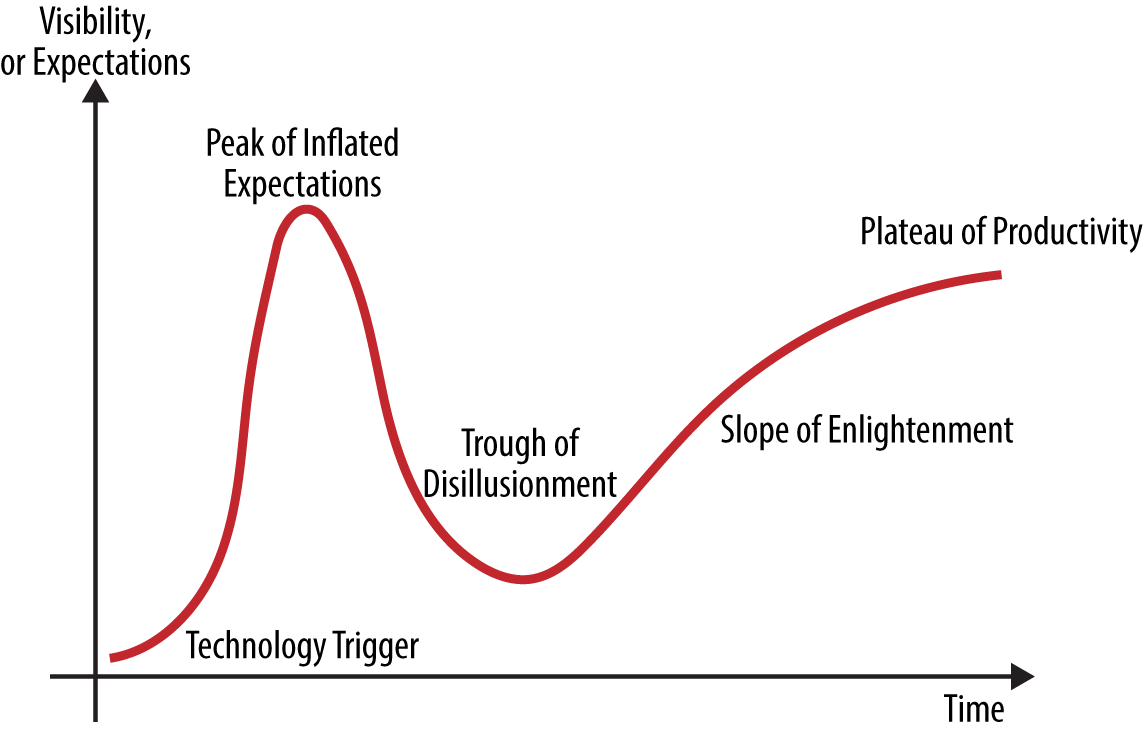Chapter 5. Getting Started with OKRs
Just like new technologies, methodologies can suffer from the hype cycle. OKRs are no exception; Iâve met a number of people deeply disillusioned with OKRs and unwilling to give them a second chance. But just like Lean or Agile, simply because a given company implements the approach badly does not mean the approach has no value.
When a company first hears about the Objective and Key Result approach, they are excited.
âNow I know what the secret of success is!â and they rush to implement it across the entire company. Often a manager thinks this is the silver bullet sheâs been seeking. This feeling is well documented by Gartnerâitâs called a Hype Curve (see Figure 5-1).
But the first time you try OKRs, you are likely to fail. Although OKRs are not complicated, they are difficult work and often require cultural change. Failure can be a dangerous situation, as your team can become disillusioned with the approach and be unwilling to try them again. You donât want to lose a powerful tool just because it takes a little time to master.

Figure 5-1. Gartnerâs Hype Curve
There are three approaches you can use to reduce this risk:
- Start with only one OKR for the company
-
By setting a simple goal for the company, your team sees the executive team holding itself to a high standard. It wonât be surprising when next quarter it is asked to the do the same. And by not cascading it, you both simplify implementation and see who chooses to adopt OKRs and who will need coaching.
- Have one team adopt OKRs before the entire company does
-
Choose an independent team that has all the skills to achieve its goals. You can then trumpet its success if it happens, or wait a cycle or two until it perfects its approach and then roll out OKRs across the company.
- Start out by applying OKRs to projects to train people on the objective-result approach
-
The company GatherContent is a great example. Every time it has a major project, it first asks what the objective is for this project and how we will know if weâve succeeded. (This case study is included in my new book, Radical Focus (Boxes & Arrows, 2016).
In all these approaches, avoid the deadly OKR mistakes and focus on learning what works in your company culture. By starting small and tracking how OKRs will work in your organization, you increase the chances of your company adopting a results-based approach, and reduce the danger of a disillusioned team.
OKRs are not a silver bullet. They should be part of a suite of approaches a company adopts. They exist to create focus while increasing employee satisfaction and productivity. Combined with Lean, Agile, and a strong management approach, OKRs will help get you out of the trough of disillusionment to the plateau of productivity.
Quick Tips for Using OKRs
-
Set only one OKR for the company, unless you have multiple business lines. Itâs about focus.
-
Give yourself three months for an OKR to have an effect. How bold is it if you can do it in a week?
-
Keep the metrics out of the Objective. The Objective is inspirational.
-
In the weekly check-in, open with the company OKR, and then do groups. Donât do every individual; thatâs better in private one-on-ones, which you do have every week, right?
-
OKRs cascade; set company OKRs, and then groups/roles, and then individuals.
-
OKRs are not the only thing you do; they are the one thing you must do. Trust people to keep the ship running, and donât jam every task into your OKRs.
-
The Monday OKR check in is a conversation. Be sure to discuss change in confidence, health metrics, and priorities.
-
Encourage employees to suggest company OKRs. OKRs are great bottom up, not just top down.
-
Make OKRs available publicly. Google has them on their intranet.
-
Friday celebrations are an antidote to Mondayâs grim business. Keep it upbeat!
Get Introduction to OKRs now with the O’Reilly learning platform.
O’Reilly members experience books, live events, courses curated by job role, and more from O’Reilly and nearly 200 top publishers.

